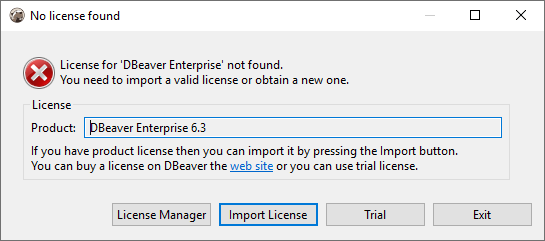License Administration
Table of contents
Note: This feature is available in Lite, Enterprise, and Ultimate editions only.
Manual license import
Commercial versions of DBeaver ask the user to import the license file if they cannot find it locally. It is the most simple and convenient way to import the product license for individual users.

License management automation
There are several ways to automate the license management process. It makes sense for a multi-user environment.
Put the license file to the predefined locations
While DBeaver is starting up, it will look for a license file in the following locations:
- Windows
%HOMEPATH%\.dbeaver-ee-license.dat%APPDATA%\DBeaverData\workspace6\.metadata\.dbeaver-ee-license.dat
- MacOS X
~/.dbeaver-ee-license.dat~/Library/DBeaverData/workspace6/.metadata/.dbeaver-ee-license.dat
- Linux
~/.dbeaver-ee-license.dat$XDG_DATA_HOME/DBeaverData/workspace6/.metadata/.dbeaver-ee-license.dat
It's important to note that the license .dat file doesn't exist. It has to be created. The information from the license.txt file that exists should be copied to the newly created .dat file.
Please follow the next steps:
- Install DBeaver
- Create the license .dat file. It should be named as
.dbeaver-%PRODUCT_PREFIX%-license.dat(.dbeaver-ue-license.dat, .dbeaver-ee-license.dat, .dbeaver-le-license.dat). The file's location is%APPDATA%in the end user home (C:\Users\Eloise\AppData\Roaming\DBeaverData\workspace6\.metadata\.dbeaver-ue-license.dat) or%HOMEPATH%(C:\Users\Eloise\.dbeaver-le-license.dat). - Add text from the license .txt file (NOT including headers) to the .dat file.
- Launch DBeaver from Start Menu
Passing license file through command line
You can add the command line parameter license <license-path> to the DBeaver EE shortcut.
Also, you can add this parameter to the dbeaver.ini config file.
Command line reference.
